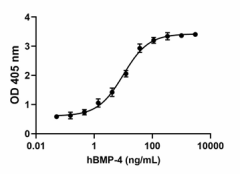- Regulatory Status
- RUO
- Other Names
- Bone Morphogenetic Protein 4, Bone Morphogenetic Protein 2B, BMP4, BMP2B, BMP2B1

-

Recombinant human BMP-4 induces alkaline phosphatase production in the chondrogenic cell line ATDC5. The ED50 for this effect is 3– 18 ng/mL. -

Stability Testing for Recombinant Human BMP-4. Recombinant human BMP-4 was aliquoted in 0.1% trifluoroacetic acid (TFA) at 0.2 mg/mL and one aliquot was kept at 4°C (Control), and another was frozen and thawed four times (4x Freeze/Thaw). After this procedure, the samples were tested for their ability to induce alkaline phosphatase production in the chondrogenic cell line ATDC5. The ED50 for this effect is 3– 18 ng/mL.
| Cat # | Size | Price | Quantity Check Availability | ||
|---|---|---|---|---|---|
| 795604 | 25 µg | $129.00 | |||
| 795606 | 100 µg | $323.00 | |||
Bone morphogenetic proteins (BMPs) are multi-functional growth factors that belong to the transforming growth factor beta (TGFbeta) superfamily. BMPs play a key role in embryonic development, especially during heart, neural and cartilage development. Around 20 BMP family members have been identified and characterized. BMPs signal through serine/threonine kinase receptors, composed of type I and II subtypes. Four type I receptors have been identified: type IA and IB BMP receptors, type IA activin receptor, and activin receptor-like kinase I. Three type II receptors have also been recognized: type II BMP receptor and type II / IIB activin receptors. The BMP-4 gene is conserved across human, chimpanzee, Rhesus monkey, dog, cow, mouse, rat, and zebrafish species. BMP-2 and BMP-4 are highly similar, with a 92% amino acid sequence identity. BMP-4 is required for mesoderm formation and patterning in mice, and BMP-4 KO mice are embryonic-lethal. BMP-4 has an important role in postnatal tooth cytodifferentiation. Overexpression of BMP-4 has been associated with fibrodysplasia ossificans progressiva (FOP). Overexpression of BMP-4 has also been associated with cancer, including melanoma, hepatocellular carcinoma, adenocarcinoma and colorectal cancer cell lines. This overexpression can promote migratory and invasive properties of cancer cells.
Product Details
- Source
- Human BMP-4, amino acid (Ser293-Arg408) (Accession: P12644), was expressed in CHO cells.
- Molecular Mass
- The 116 amino acid recombinant protein has a predicted molecular mass of approximately 13 kD. The DTT-reduced and non-reduced protein migrates at approximately 20 kD and 40 kD by SDS-PAGE, respectively. The predicted N-terminal amino acid is Ser.
- Purity
- > 95%, as determined by Coomassie stained SDS-PAGE
- Formulation
- 0.22 µm filtered protein solution is in 0.1% TFA.
- Endotoxin Level
- Less than 0.1 EU per µg cytokine as determined by the LAL method
- Concentration
- 10 and 25 µg sizes are bottled at 200 µg/mL. 100 µg size and larger sizes are lot-specific and bottled at the concentration indicated on the vial. To obtain lot-specific concentration and expiration, please enter the lot number in our Certificate of Analysis online tool.
- Storage & Handling
- Unopened vial can be stored between 2°C and 8°C for up to 2 weeks at -20°C for up to six months, or at -70°C or colder until the expiration date. For maximum results, quick spin vial prior to opening. The protein can be aliquoted and stored at -20°C or colder. Stock solutions can also be prepared at 50 - 100 µg/mL in appropriate sterile buffer, carrier protein such as 0.2 - 1% BSA or HSA can be added when preparing the stock solution. Aliquots can be stored between 2ᵒC and 8°C for up to one week and stored at -20°C or colder for up to 3 months. Avoid repeated freeze/thaw cycles.
- Activity
- BMP-4 induces alkaline phosphatase production in the chondrogenic cell line ATDC5. The ED50 for this effect is 3– 18 ng/mL.
- Application
-
Bioassay
- Application Notes
-
BioLegend carrier-free recombinant proteins provided in liquid format are shipped on blue-ice. Our comparison testing data indicates that when handled and stored as recommended, the liquid format has equal or better stability and shelf-life compared to commercially available lyophilized proteins after reconstitution. Our liquid proteins are validated in-house to maintain activity after shipping on blue ice and are backed by our 100% satisfaction guarantee. If you have any concerns, contact us at tech@biolegend.com.
- Product Citations
-
Antigen Details
- Structure
- Disulfide-linked homodimer
- Distribution
-
Osteoblast, odontoblast, ameloblasts, megakaryocytes, endothelial cells. Lymphoblastoid cell lines from patients with fibrodysplasia ossificans progressiva.
- Function
- Neural Stem Cells, mesenchymal stem cells, hematopoietic stem and progenitors, embryonic stem cells
- Interaction
- Condroblast, osteoblast, retinoblastoma cells
- Ligand/Receptor
- Type I receptors BMPR-IA (ALK-3) and BMPR-IB (ALK-6).
- Bioactivity
- BMP-4 induces alkaline phosphatase production in the chondrogenic cell line ATDC5.
- Cell Type
- Astrocytes, Embryonic Stem Cells, Mesenchymal Stem Cells, Oligodendrocytes
- Biology Area
- Cardiovascular Biology, Cell Biology, Immuno-Oncology, Neurodegeneration, Stem Cells
- Molecular Family
- Growth Factors
- Gene ID
- 652 View all products for this Gene ID
- UniProt
- View information about BMP-4 on UniProt.org
